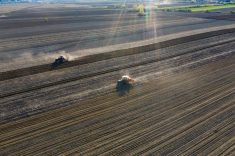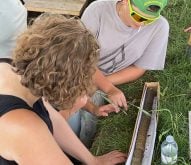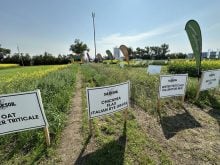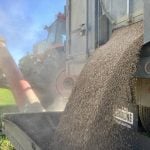Glacier FarmMedia — Managing soil pH is a crucial but often overlooked aspect of soil health and crop productivity, says Marla Riekman, a land management specialist with Manitoba Agriculture.
“[The] pH is a measure of hydrogen ion activity in the soil,” Riekman said during a Manitoba Agriculture Crop Talk online seminar last month.
The pH scale is logarithmic, with each whole number indicating a tenfold shift in hydrogen ion activity. A neutral pH is seven, with values above that indicating less hydrogen ion activity, making the soil more alkaline. Values below seven indicate more hydrogen ion activity, making the soil more acidic.
Read Also

Claas brings 1000 Series SP forage harvesters to Canada
In mid-August, Claas unveiled its new line of Jaguar forage harvesters at an event in Visalia, California, deep in the heart of that state’s dairy region.
A shift from pH five to six represents a tenfold decrease in hydrogen ion activity, and a shift from six to seven represents another tenfold decrease, Riekman says. This means moving from pH 5 to pH 7 results in a 100-fold decrease in hydrogen ion activity. Small changes in pH reflect significant shifts in acidity or alkalinity due to the exponential nature of the scale.
READ MORE: Liming and soil acidity
Soil pH in Manitoba tends to be on the higher end of the scale, with most soils testing in the neutral to alkaline range, Riekman says. Data Riekman shared from 2001 show fewer than 10 per cent of Manitoba soils had a pH of six or lower.
Sandy, well-leached soils, such as those found in the Assiniboine Delta and southeastern Manitoba, tend to be more acidic due to the loss of calcium and magnesium over time, Riekman says.
“Anywhere where you consider soils to be either sandier or more weathered — soils that have higher precipitation and have more leaching over time and weathering as they’ve developed — you tend to have a lower pH,” she says.
Over time, the more basic elements like calcium and magnesium leach through the profiles, leaving hydrogen behind.
Different crops thrive at different pH levels, Riekman says.
“Some plant species have very specific pH requirements. Some plants will be more tolerant of acidic conditions, or more tolerant of alkaline conditions, and that can help us to target certain plant species based on that.”
Acidic soils can reduce the availability of essential nutrients and inhibit nitrogen-fixing bacteria.
“When we’re talking about things like soil-applied herbicides, their performance can be decreased when you have more acidic soils,” Riekman says, adding that liming is a key strategy for managing acidic soils.
“It’s going to decrease those potential metal toxicities, or aluminum toxicity; it can improve the physical condition of the soil.”
However, lowering soil pH in high-pH soils is difficult, Riekman said. One study from North Dakota showed applying 8,000 pounds of elemental sulfur per acre in South Dakota lowered pH from 7.8 to 5.7 but significantly increased soil salinity.
It’s important to know soil pH when applying herbicides, says Kim Brown, a weed specialist with Manitoba Agriculture who also attended the Crop Talk.
“You do have to watch for some of our soil-applied herbicide. … There’s certain limitations on some of our herbicides,” she says.















